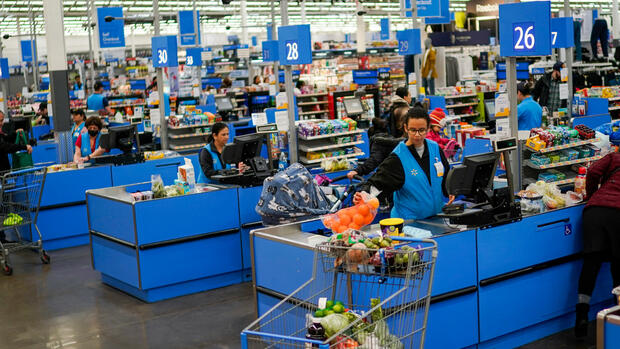If the middle class also buys more from the discounter, that is a clear economic indicator.
(Photo: AP)
new York The quarterly season for US retailers is in full swing. If discounters like Walmart and Target present figures, this is not only interesting for shareholders. Economists are also looking closely. The data are considered important economic indicators: because if the middle class does their shopping at discounters or the hardware store chains are left sitting on patio furniture, the mood to buy is inhibited – people have to save.
The figures recently released make a mild recession by the end of the year seem more likely. On Thursday, electronics chain Best Buy reported better-than-expected earnings but lower sales and a more cautious outlook. Previously, Walmart, Target and the outdoor outfitter Dick’s Sporting Goods had presented some good, but at least decent results. In contrast, home improvement stores Home Depot and Lowe’s lowered their forecasts for the rest of the year after weak sales.
While countries like Germany are much more dependent on exports, the US economy rises and falls with consumers. “Their situation is so important because the US economy is the largest in the world and US households are responsible for two-thirds of the US economy,” said Sal Guatieri of BMO Capital Markets. That’s why the economist not only looks at the monthly retail data from the US census office, but also at the companies’ quarterly figures.
What economists read from the current balance sheets of Walmart, Target or Lowe’s is clear: “We see clear signals that budgets are under pressure,” explains Guatieri – and not just because of the high inflation. It’s also about a possible harder time granting personal loans due to the recent problems at the US regional banks.
Walmart boss Doug McMillon looks primarily at inflation. It is “one of the main factors causing uncertainty for us in the second half of the year,” he said in an interview with analysts when the quarterly figures were presented. “These prices have to come down,” McMillon warned – because they “hit families that we serve.”
US citizens shop less – but they shop
At Walmart in particular, you can clearly see that middle- and lower-income families are turning to cheaper products: “People are trying to stretch their dollars,” observes Guatieri. Overall, US consumers are battered but “still alive.”
>> Read here: Inflation falls slightly to 4.9 percent. Fed rate speculation
The most recent estimates by the census office for retail sales figures in April, which were 0.4 percent higher than in March, would also have shown this: People may not be shopping as freely as before – but they are shopping.
Therefore, according to Guatieri, the beginning of a recession could be postponed by another quarter. In any case, BMO Capital Markets expects “a very mild recession” in which unemployment will rise by a little more than one percent.
These prices need to come down. Walmart CEO Doug McMillon
Neil Saunders, managing director of analytics firm GlobalData, also observes that Americans are “getting more nervous and changing their spending.” Large, low-cost retailers like Walmart and Target could defy this environment. But DIY and furniture stores are suffering from two factors: inflation and stagnation in the real estate market.
“I don’t think the current situation is already indicative of a recession,” says Sanders. “But the latest quarterly numbers and official retail numbers are clearly pointing to a slowdown.” But there are also less concerned voices, such as Ben Emons, portfolio manager at NewEdge Wealth: “What we’re seeing from Walmart and other retailers is that the US -Economy is not in recession at all. In fact, it’s growing.
More: Why Biden is more successful with his industrial policy than the Europeans
